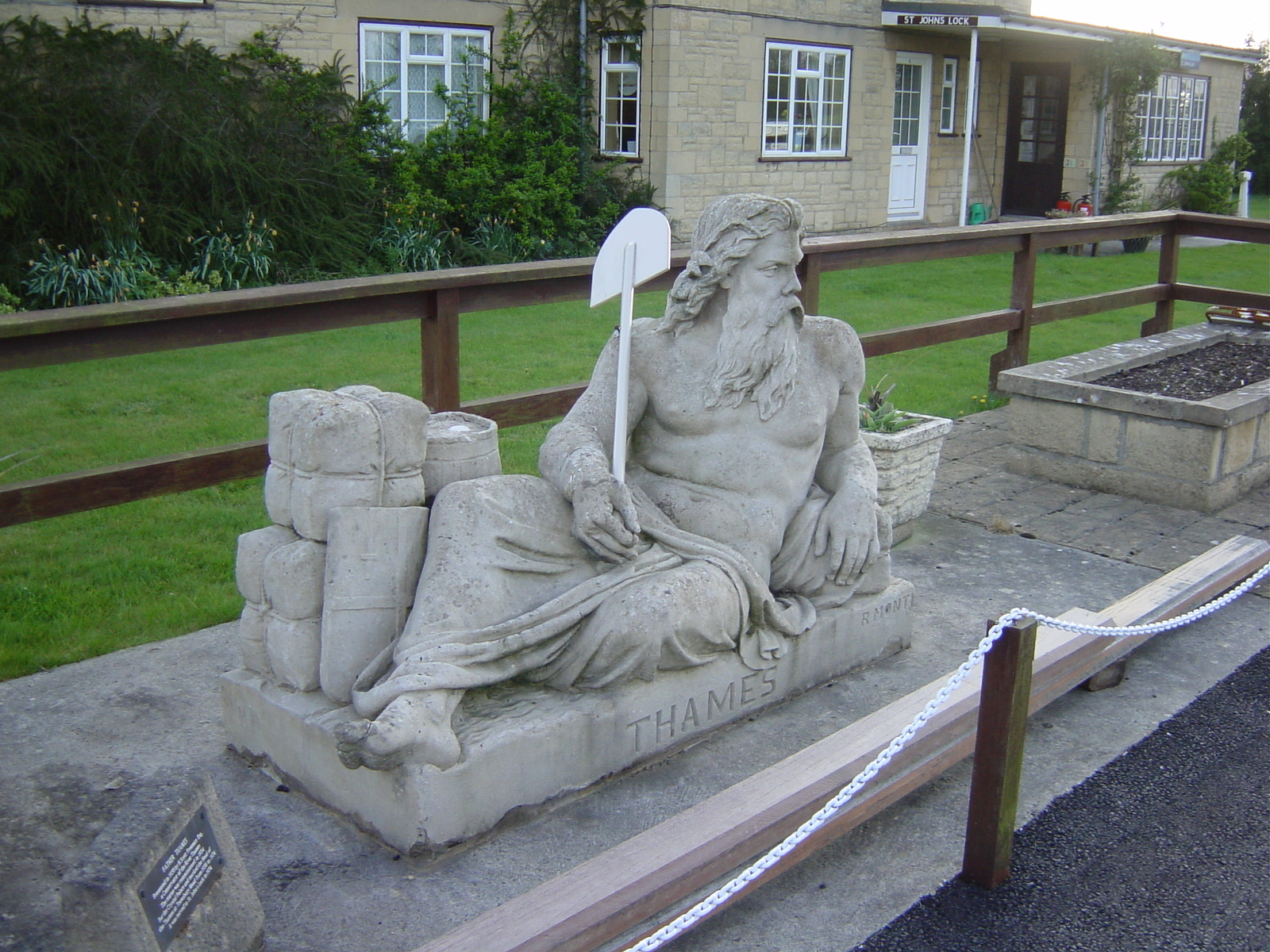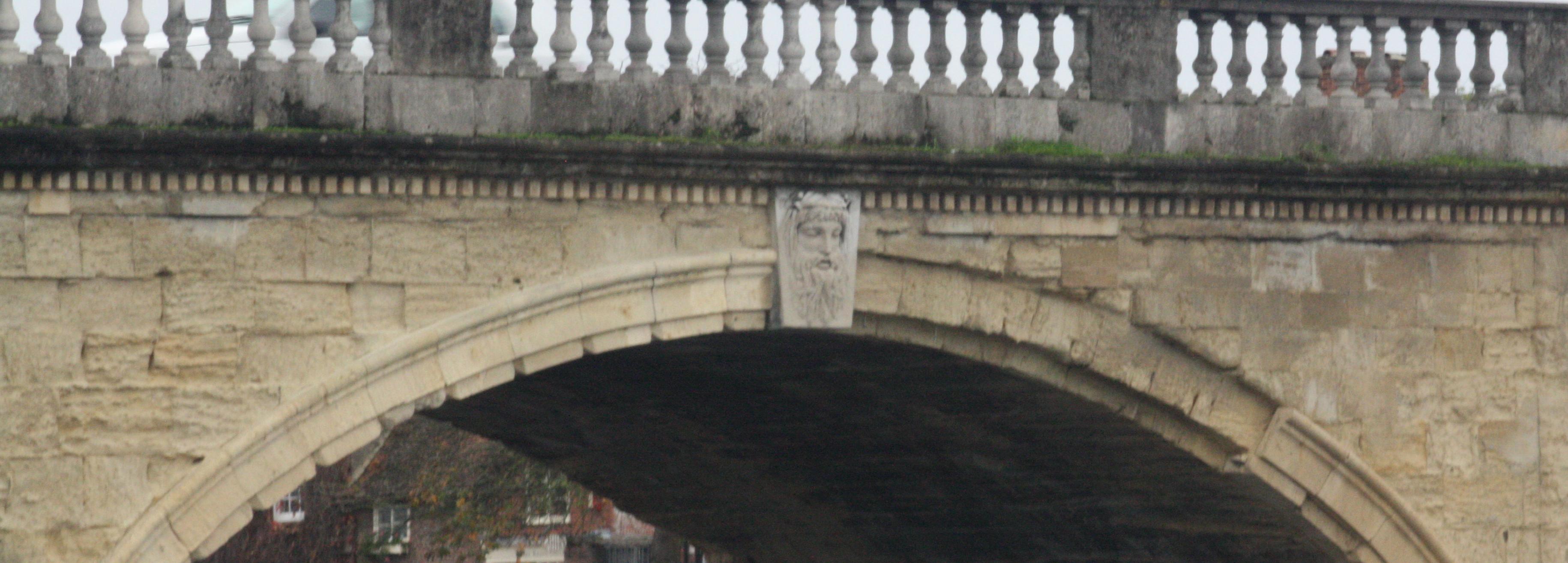Old Father Thames on:
[Wikipedia]
[Google]
[Amazon]
The River Thames ( ), known alternatively in parts as the River Isis, is a river that flows through southern England including London. At , it is the longest river entirely in England and the second-longest in the United Kingdom, after the River Severn.
The river rises at Thames Head in Gloucestershire, and flows into the North Sea near Tilbury, Essex and
 According to Mallory and Adams, the Thames, from Middle English ''Temese'', is derived from the Brittonic name for the river, ''Tamesas'' (from *''tamēssa''),Mallory, J.P. and D.Q. Adams (1947). ''The Encyclopedia of Indo-European Culture''. London: Fitzroy and Dearborn. p. 147. recorded in Latin as ''Tamesis'' and yielding modern Welsh ''Tafwys'' "Thames". The name may have meant "dark" and can be compared to other
According to Mallory and Adams, the Thames, from Middle English ''Temese'', is derived from the Brittonic name for the river, ''Tamesas'' (from *''tamēssa''),Mallory, J.P. and D.Q. Adams (1947). ''The Encyclopedia of Indo-European Culture''. London: Fitzroy and Dearborn. p. 147. recorded in Latin as ''Tamesis'' and yielding modern Welsh ''Tafwys'' "Thames". The name may have meant "dark" and can be compared to other  The Thames through Oxford is sometimes called the Isis. Historically, and especially in
The Thames through Oxford is sometimes called the Isis. Historically, and especially in
Gravesend
Gravesend is a town in northwest Kent, England, situated 21 miles (35 km) east-southeast of Charing Cross (central London) on the Bank (geography), south bank of the River Thames and opposite Tilbury in Essex. Located in the diocese of Ro ...
, Kent, via the Thames Estuary. From the west it flows through Oxford (where it is sometimes called the Isis), Reading, Henley-on-Thames
Henley-on-Thames ( ) is a town and civil parish on the River Thames in Oxfordshire, England, northeast of Reading, west of Maidenhead, southeast of Oxford and west of London (by road), near the tripoint of Oxfordshire, Berkshire and Buc ...
and Windsor. The Thames also drains the whole of Greater London
Greater may refer to:
*Greatness, the state of being great
*Greater than, in inequality (mathematics), inequality
*Greater (film), ''Greater'' (film), a 2016 American film
*Greater (flamingo), the oldest flamingo on record
*Greater (song), "Greate ...
.
In August 2022, the source of the river moved five miles to beyond Somerford Keynes due to the heatwave in July 2022.
The lower reaches of the river are called the Tideway, derived from its long tidal reach up to Teddington Lock. Its tidal section includes most of its London stretch and has a rise and fall of . From Oxford to the Estuary the Thames drops by 55 metres. Running through some of the drier parts of mainland Britain and heavily abstracted for drinking water, the Thames' discharge is low considering its length and breadth: the Severn has a discharge almost twice as large on average despite having a smaller drainage basin. In Scotland, the Tay
Tay may refer to:
People and languages
* Tay (name), including lists of people with the given name, surname and nickname
* Tay people, an ethnic group of Vietnam
** Tày language
*Atayal language, an Austronesian language spoken in Taiwan (ISO 639 ...
achieves more than double the Thames' average discharge from a drainage basin that is 60% smaller.
Along its course are 45 navigation locks with accompanying weirs. Its catchment area covers a large part of south-eastern and a small part of western England; the river is fed by at least 50 named tributaries. The river contains over 80 islands. With its waters varying from freshwater to almost seawater, the Thames supports a variety of wildlife and has a number of adjoining Sites of Special Scientific Interest, with the largest being in the North Kent Marshes and covering .
Etymology
 According to Mallory and Adams, the Thames, from Middle English ''Temese'', is derived from the Brittonic name for the river, ''Tamesas'' (from *''tamēssa''),Mallory, J.P. and D.Q. Adams (1947). ''The Encyclopedia of Indo-European Culture''. London: Fitzroy and Dearborn. p. 147. recorded in Latin as ''Tamesis'' and yielding modern Welsh ''Tafwys'' "Thames". The name may have meant "dark" and can be compared to other
According to Mallory and Adams, the Thames, from Middle English ''Temese'', is derived from the Brittonic name for the river, ''Tamesas'' (from *''tamēssa''),Mallory, J.P. and D.Q. Adams (1947). ''The Encyclopedia of Indo-European Culture''. London: Fitzroy and Dearborn. p. 147. recorded in Latin as ''Tamesis'' and yielding modern Welsh ''Tafwys'' "Thames". The name may have meant "dark" and can be compared to other cognate
In historical linguistics, cognates or lexical cognates are sets of words in different languages that have been inherited in direct descent from an etymology, etymological ancestor in a proto-language, common parent language. Because language c ...
s such as Russian темно ( Proto-Slavic *''tĭmĭnŭ''), Lithuanian
Lithuanian may refer to:
* Lithuanians
* Lithuanian language
* The country of Lithuania
* Grand Duchy of Lithuania
* Culture of Lithuania
* Lithuanian cuisine
* Lithuanian Jews as often called "Lithuanians" (''Lita'im'' or ''Litvaks'') by other Jew ...
''tamsi'' "dark", Latvian ''tumsa'' "darkness", Sanskrit '' tamas'' and Welsh ''tywyll'' "darkness" and Middle Irish ''teimen'' "dark grey". The origin is shared by many other river names in Britain, such as the River Tamar at the border of Devon and Cornwall, several rivers named Tame in the Midlands and North Yorkshire, the Tavy on Dartmoor, the Team of the North East, the Teifi and Teme of Wales, the Teviot in the Scottish Borders
The Scottish Borders ( sco, the Mairches, 'the Marches'; gd, Crìochan na h-Alba) is one of 32 council areas of Scotland. It borders the City of Edinburgh, Dumfries and Galloway, East Lothian, Midlothian, South Lanarkshire, West Lothi ...
and a Thames tributary the Thame.
Kenneth H. Jackson proposed that the name of the Thames is not Indo-European (and of unknown meaning), while Peter Kitson suggested that it is Indo-European but originated before the Britons and has a name indicating "muddiness" from a root ''*tā-'', 'melt'.
Indirect evidence for the antiquity of the name 'Thames' is provided by a Roman potsherd found at Oxford, bearing the inscription ''Tamesubugus fecit'' (Tamesubugus made his. It is believed that Tamesubugus' name was derived from that of the river. Tamese was referred to as a place, not a river in the Ravenna Cosmography (c. AD 700).
The river's name has always been pronounced with a simple ''t'' /t/; the Middle English spelling was typically ''Temese'' and the Brittonic form ''Tamesis''. A similar spelling from 1210, "Tamisiam" (the accusative case of "Tamisia", see Kingston upon Thames#Early history), is found in the Magna Carta
(Medieval Latin for "Great Charter of Freedoms"), commonly called (also ''Magna Charta''; "Great Charter"), is a royal charter of rights agreed to by King John of England at Runnymede, near Windsor, on 15 June 1215. First drafted by the ...
.
Victorian
Victorian or Victorians may refer to:
19th century
* Victorian era, British history during Queen Victoria's 19th-century reign
** Victorian architecture
** Victorian house
** Victorian decorative arts
** Victorian fashion
** Victorian literature ...
times, gazetteers and cartographers insisted that the entire river was correctly named the Isis from its source down to Dorchester on Thames and that only from this point, where the river meets the Thame and becomes the "Thame-isis" (supposedly subsequently abbreviated to Thames) should it be so called. Ordnance Survey maps still label the Thames as "River Thames or Isis" down to Dorchester. Since the early 20th century this distinction has been lost in common usage outside of Oxford, and some historians suggest the name ''Isis'' is nothing more than a truncation
In mathematics and computer science, truncation is limiting the number of digits right of the decimal point.
Truncation and floor function
Truncation of positive real numbers can be done using the floor function. Given a number x \in \mathbb ...
of ''Tamesis'', the Latin name for the Thames. Sculptures titled ''Tamesis'' and '' Isis'' by Anne Seymour Damer can be found on the bridge at Henley-on-Thames
Henley-on-Thames ( ) is a town and civil parish on the River Thames in Oxfordshire, England, northeast of Reading, west of Maidenhead, southeast of Oxford and west of London (by road), near the tripoint of Oxfordshire, Berkshire and Buc ...
, Oxfordshire
Oxfordshire is a ceremonial and non-metropolitan county in the north west of South East England. It is a mainly rural county, with its largest settlement being the city of Oxford. The county is a centre of research and development, primarily ...
(the original terracotta and plaster models were exhibited at the Royal Academy
The Royal Academy of Arts (RA) is an art institution based in Burlington House on Piccadilly in London. Founded in 1768, it has a unique position as an independent, privately funded institution led by eminent artists and architects. Its pur ...
, London, in 1785. They are now on show at the River and Rowing Museum in Henley).
Richard Coates suggests that while the river was as a whole called the Thames, part of it, where it was too wide to ford, was called *''(p)lowonida''. This gave the name to a settlement on its banks, which became known as Londinium
Londinium, also known as Roman London, was the capital of Roman Britain during most of the period of Roman rule. It was originally a settlement established on the current site of the City of London around AD 47–50. It sat at a key cross ...
, from the Indo-European roots *''pleu-'' "flow" and *''-nedi'' "river" meaning something like the flowing river or the wide flowing unfordable river.
The river gives its name to three informal areas: the Thames Valley, a region of England around the river between Oxford and West London; the Thames Gateway; and the greatly overlapping Thames Estuary around the tidal Thames to the east of London and including the waterway itself. Thames Valley Police is a formal body that takes its name from the river, covering three counties. In non-administrative use, the river's name is used in those of Thames Valley University, Thames Water, Thames Television, publishing company Thames & Hudson
Thames & Hudson (sometimes T&H for brevity) is a publisher of illustrated books in all visually creative categories: art, architecture, design, photography, fashion, film, and the performing arts. It also publishes books on archaeology, history, ...
, Thameslink (north–south rail service passing through central London
Central London is the innermost part of London, in England, spanning several boroughs. Over time, a number of definitions have been used to define the scope of Central London for statistics, urban planning and local government. Its characteris ...
) and